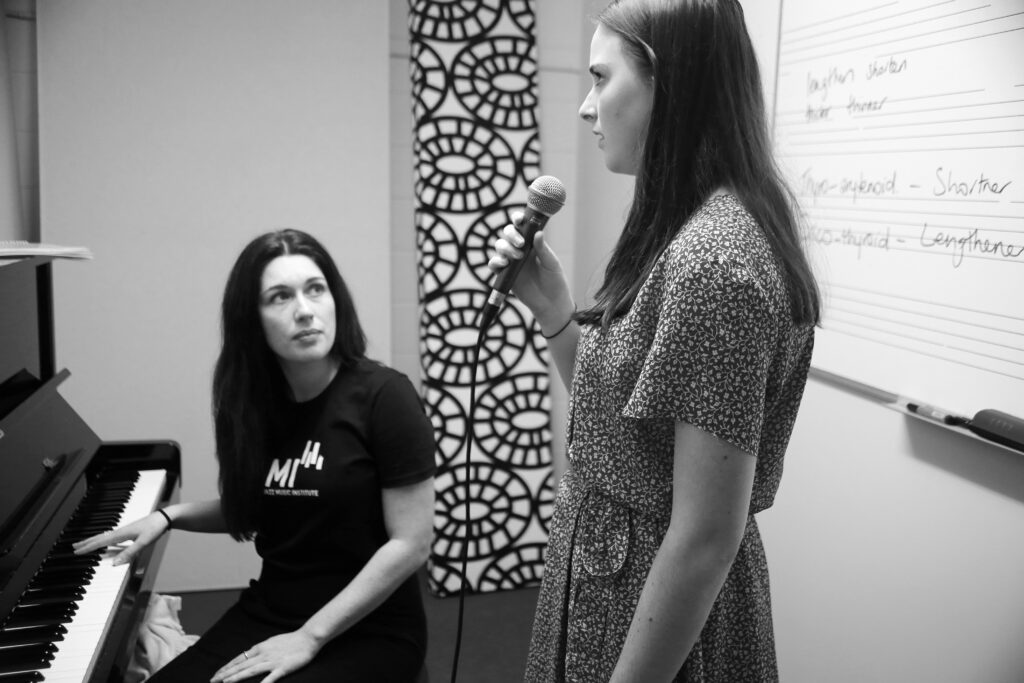By Hayley Cox (GradDipMus, BMus, MMus), Vocal lecturer at JMI
For a vocalist, the instrument is not solely the larynx, nor the efficiency of the respiratory system but the entire body. From the head balanced over the spine, right down to the arches of your feet, the physiology of these positions and everything in between can determine the efficiency of the singing voice. Due to this, I use a holistic approach through vocal coaching in Brisbane and this approach should be employed across all genres of vocal music.
Within the context of a vocal lesson of any genre, there can be two main umbrellas of focus when dealing with the singing voice. Those two areas of concentration are split into vocal technique and vocal style. When addressing vocal technique, the fundamentals are identical across all styles of singing and these fundamentals should be firmly in place before addressing any phonation issues. The parameters of vocal technique can differ from Classical to Contemporary styles of singing; however efficient alignment, breath flow and support are crucial in producing a free and well functioning singing voice.
When a student first steps into my teaching studio for vocal lessons in Brisbane, I find it is important that a student history is recorded. Topics including overall health, musical history and workplace conditions should all be covered as all these matters pertain to the production of the voice. As mentioned earlier, the entire body is the instrument when dealing with singing, and there are a multitude of health issues that can directly or indirectly affect the functionality of this instrument. A past student of mine had suffered from a tumor on her spine, which caused her to be misaligned. Poor alignment can be extremely problematic for any singer, as it is at the root of all technique. After uncovering further information on the student’s health issues and liaising with her physiotherapist, I had a much clearer idea on how to proceed with this particular student’s vocal technique.
 While a student history is being recorded, it is important for the singing teacher to begin their diagnosis, much in the way a doctor begins to assess their patient as soon as they walk in the door, both visually and aurally. As soon as a student begins to speak, attention should be paid to the quality of the phonation. For instance, a person who speaks with consistent vocal fry is an indication that breath flow will be a focus of vocal technique. This approach has very much improved my ability to deliver vocal coaching in Brisbane.
While a student history is being recorded, it is important for the singing teacher to begin their diagnosis, much in the way a doctor begins to assess their patient as soon as they walk in the door, both visually and aurally. As soon as a student begins to speak, attention should be paid to the quality of the phonation. For instance, a person who speaks with consistent vocal fry is an indication that breath flow will be a focus of vocal technique. This approach has very much improved my ability to deliver vocal coaching in Brisbane.
When starting to teach style within a genre, aesthetic bias must be put aside. It is imperative that a singer stays authentic to the distinctions that are true to any given genre of music. Stylistic appropriateness can often be subjective when teaching the genre of Jazz. Over the past 100 years, jazz vocals has evolved and morphed from its roots although many of the original traits of the pioneering jazz singers are evident in the most modern day jazz singers.
There are a few primary factors when beginning to assess stylistic abilities within the realm of Jazz. These factors being swing feel, phrasing, articulation, tone and improvisation. Improvisation also needs to be addressed and developed from a melodic standpoint as well as within the context of scatting. For beginner improvisers this technique can be quite intimidating, therefore it is important for a teacher to create a trusting environment within the studio. It is imperative for a jazz vocalist to be willing to take risks when improvising and they will be more willing to do so in an environment that is comfortable for them. Making mistakes is absolutely necessary for any music student, in order to learn and develop their musicianship and for jazz musicians; this is particularly pertinent when learning to improvise.
 I have often preached to students learning a myriad of genres, a large percentage of what you learn, you learn purely from listening. Reginald Thomas, a prolific music educator from the USA states in the most perfectly succinct way: ‘Music is the best teacher of Music’. This statement particularly rings true for me, as someone who was not exposed to a jazz specialist vocal tutor throughout music lessons in my undergraduate degree, I learnt almost all of my jazz styling from recordings or live performances. The genre of jazz is something that cannot entirely be taught in a studio. For instance, singing with a swing feel is a technique that can be very difficult to teach and communicate to a student, as it’s something that needs to be felt.
I have often preached to students learning a myriad of genres, a large percentage of what you learn, you learn purely from listening. Reginald Thomas, a prolific music educator from the USA states in the most perfectly succinct way: ‘Music is the best teacher of Music’. This statement particularly rings true for me, as someone who was not exposed to a jazz specialist vocal tutor throughout music lessons in my undergraduate degree, I learnt almost all of my jazz styling from recordings or live performances. The genre of jazz is something that cannot entirely be taught in a studio. For instance, singing with a swing feel is a technique that can be very difficult to teach and communicate to a student, as it’s something that needs to be felt.
There are two primary means in which a beginner jazz vocalist can autonomously hone their stylistic ability. The first step is for any jazz musicians to simply immerse themselves in the genre, being either through attending live performances or listening to jazz recordings, both vocal and instrumental. By saturating yourself with jazz music, a student will begin to understand the nuances inherent in the genre, even on a subconscious level. Secondly, transcribing is an integral method for any instrument in developing jazz style. For a vocalist, transcribing either melodies of standards, scat solos or instrumental solos, students can ‘stand on the shoulders of giants’ and obtain a better and more thorough understanding of ‘the jazz sound’.
For more information regarding courses and classes that I provide vocal coaching in Brisbane for, check out the courses available at JMI.
